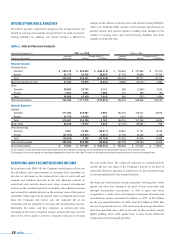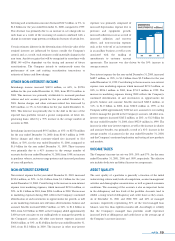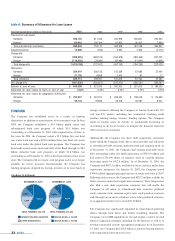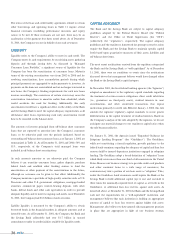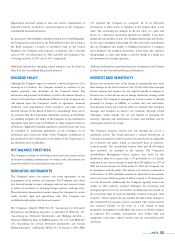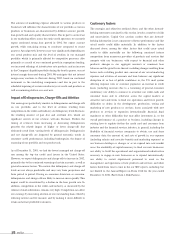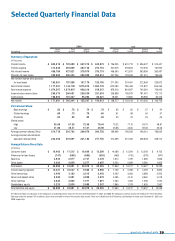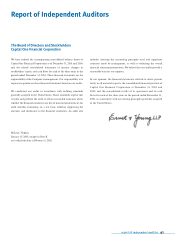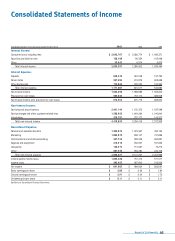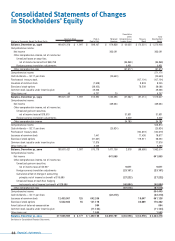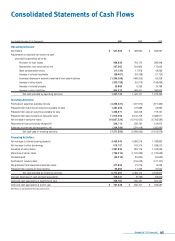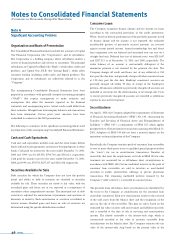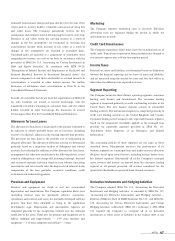Capital One 2001 Annual Report Download - page 40
Download and view the complete annual report
Please find page 40 of the 2001 Capital One annual report below. You can navigate through the pages in the report by either clicking on the pages listed below, or by using the keyword search tool below to find specific information within the annual report.
The amount of marketing expense allocated to various products or
businesses will influence the characteristics of our portfolio as various
products or businesses are characterized by different account growth,
loan growth and asset quality characteristics. Due in part to an increase
in our marketing efforts across the entire credit spectrum, we currently
expect continued strong loan growth in 2002, but expect account
growth, while remaining strong, to moderate compared to recent
quarters. Actual growth, however, may vary significantly depending on
our actual product mix and the level of attrition in our managed
portfolio, which is primarily affected by competitive pressures. Also
primarily as a result of our continued growth in superprime lending,
our increased offerings of introductory rate products, and an increase
in the Company’s liquidity portfolio during the fourth quarter, our net
interest margin decreased during 2001. We anticipate that net interest
margin may continue to fluctuate during 2002, based on continued
movement in the underlying components and due in part to the
scheduled repricing of certain introductory rate credit card products as
well as continuing shifts in our asset mix.
Impact of Delinquencies, Charge-Offs and Attrition
Our earnings are particularly sensitive to delinquencies and charge-offs
on our portfolio, and to the level of attrition resulting from
competition in the credit card industry. As delinquency levels fluctuate,
the resulting amount of past due and overlimit fees, which are
significant sources of our revenue, will also fluctuate. Further, the
timing of revenues from increasing or decreasing delinquencies
precedes the related impact of higher or lower charge-offs that
ultimately result from varying levels of delinquencies. Delinquencies
and net charge-offs are impacted by general economic trends in
consumer credit performance, including bankruptcies, the degree of
seasoning of our portfolio and our product mix.
As of December 31, 2001, we had the lowest managed net charge-off
rate among the top ten credit card issuers in the United States.
However, we expect delinquencies and charge-offs to increase in 2002,
primarily due to the continued seasoning of certain accounts, as well as
general economic factors. We caution that delinquency and charge-off
levels are not always predictable and may vary from projections and
from period to period. During an economic downturn or recession,
delinquencies and charge-offs are likely to increase more quickly. This
impact could be exacerbated by a decline in the loan growth rate. In
addition, competition in the credit card industry, as measured by the
volume of mail solicitations, remains very high. Competition can affect
our earnings by increasing attrition of our outstanding loans (thereby
reducing interest and fee income) and by making it more difficult to
retain and attract profitable customers.
Cautionary Factors
The strategies and objectives outlined above, and the other forward-
looking statements contained in this section, involve a number of risks
and uncertainties. Capital One cautions readers that any forward-
looking information is not a guarantee of future performance and that
actual results could differ materially. In addition to the factors
discussed above, among the other factors that could cause actual
results to differ materially are the following: continued intense
competition from numerous providers of products and services that
compete with our businesses; with respect to financial and other
products, changes in our aggregate accounts or consumer loan
balances and the growth rate thereof, including changes resulting from
factors such as shifting product mix, amount of our actual marketing
expenses and attrition of accounts and loan balances; any significant
disruption of, or loss of public confidence in, the U.S. mail system
affecting response rates or customer payments; an increase in credit
losses (including increases due to a worsening of general economic
conditions); our ability to continue to securitize our credit cards and
consumer loans and to otherwise access the capital markets at
attractive rates and terms to fund our operations and future growth;
difficulties or delays in the development, production, testing and
marketing of new products or services; losses associated with new
products or services or expansion internationally; financial, legal,
regulatory or other difficulties that may affect investment in, or the
overall performance of, a product or business, including changes in
existing laws to regulate further the credit card and consumer loan
industry and the financial services industry, in general, including the
flexibility of financial services companies to obtain, use and share
consumer data; the amount of, and rate of growth in, our expenses
(including salaries and associate benefits and marketing expenses) as
our business develops or changes or as we expand into new market
areas; the availability of capital necessary to fund our new businesses;
our ability to build the operational and organizational infrastructure
necessary to engage in new businesses or to expand internationally;
our ability to recruit experienced personnel to assist in the
management and operations of new products and services; and other
factors listed from time to time in the our SEC reports, including, but
not limited to, the Annual Report on Form 10-K for the year ended
December 31, 2001 (Part I, Item 1, Risk Factors).
38 md&a


